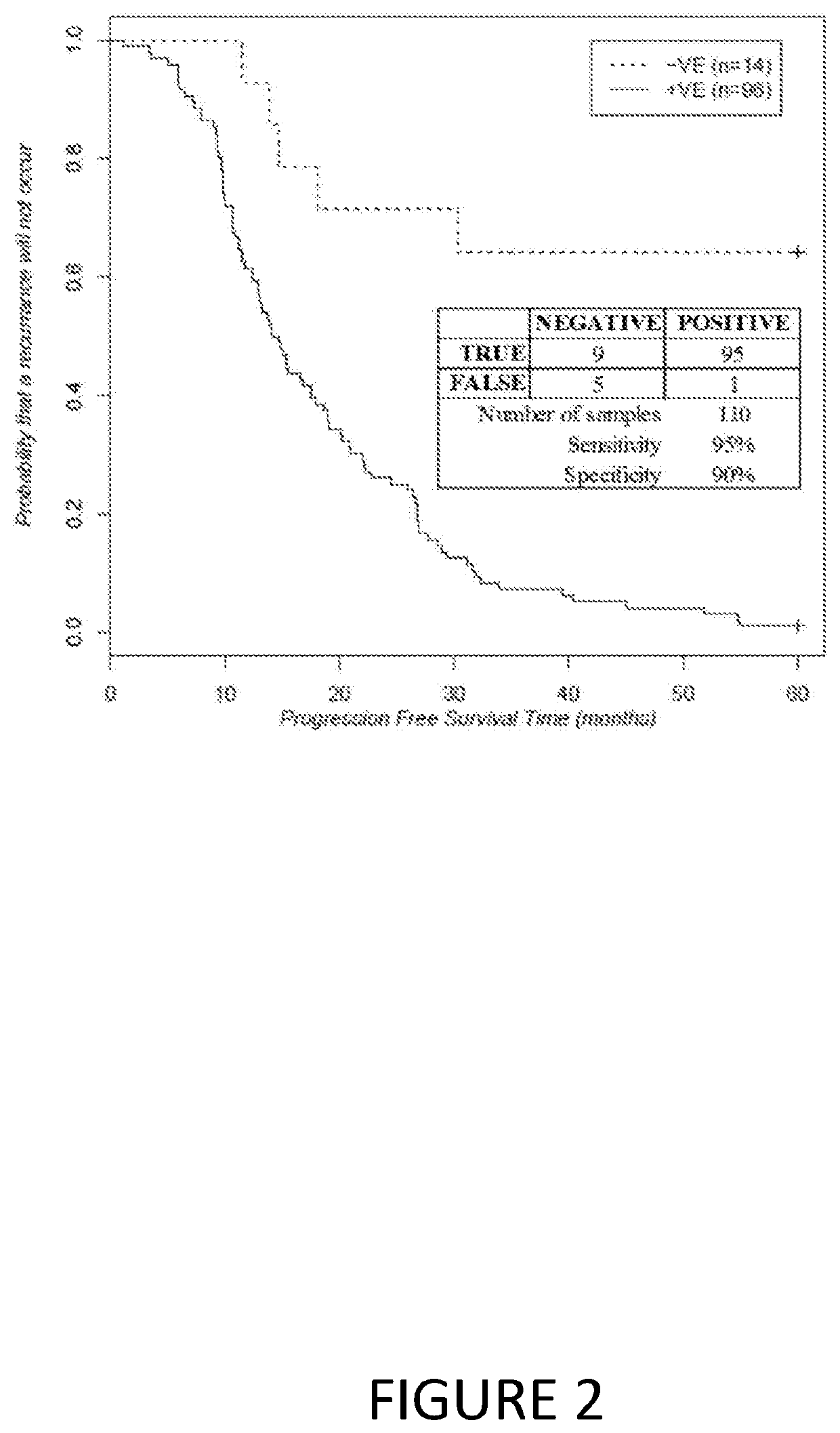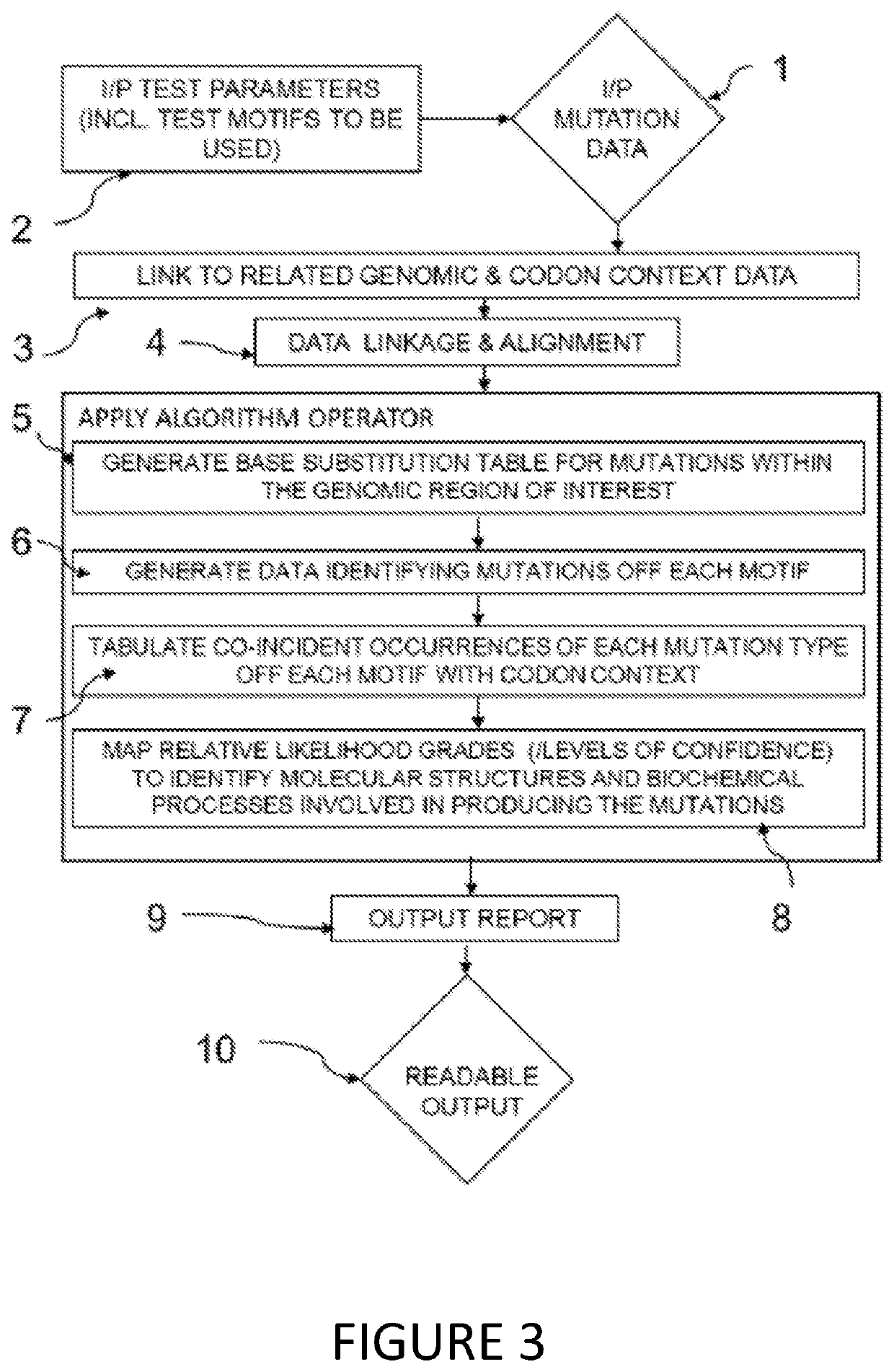Methods of detecting cancer recurrence
a cancer recurrence and probability technology, applied in the direction of microbiological testing/measurement, biochemistry apparatus and processes, drug compositions, etc., can solve the problems of reducing, changing, discontinuing an existing anti-cancer therapy, etc., to achieve increased risk of developing cancer, increased specificity and sensitivity, and the effect of heavy course of anti-cancer therapy
- Summary
- Abstract
- Description
- Claims
- Application Information
AI Technical Summary
Benefits of technology
Problems solved by technology
Method used
Image
Examples
example 1
Mutation Strand-Bias Pattern Resembles Other Cancers
[0167]Previous studies have shown that the somatic hypermutation (SHM) reference pattern observed at rearranged immunoglobulin variable region loci is characterized by significant strand-biases evident for all Watson-Crick complements (see, for example, Steele and Lindley, 2010). The present studies provide the first evidence that the striking SHM-like strand biased pattern is also observed for somatic mutations occurring in lung adenocarcinoma, lung small cell carcinoma, breast ductal carcinoma, squamous cell carcinoma, and malignant melanoma. Accordingly, it was determined whether the strand-bias pattern for the TCGA serous ovarian adenocarcinoma mutation dataset also exhibited this strand bias. The results strongly suggest that there is a causal relationship between aberrant Ig SHM and the genesis of somatic point mutations in many cancers. This in turn suggests that the potential targets involved in SHM such as AID and ADAR1, a...
example 2
TSM Profiles Indicate AID / APOBEC3G / APOBEC3B and ADAR1 Deaminase Activity
[0180]A TSM profile for the selected motifs for AID (WRCG / CGYW, where W=A / T; Y=T / C; and R=A / G), APOBEC3G (CCG / CGG), APOBEC3B (TCG / CGA) and ADAR1 (WAY, where W=A / T; and Y=T / C) is shown in Table 5. The Chi Square level of statistical significance for deviation from the expected is shown for mutations off each motif in a 3×3 dataset. All 3×3 datasets show a strong preference for mutations of a particular type, and at a preferred target location for significant level p<0.001 (8 df). It is important to note that although isoforms of the DBDs are known to exist for each deaminase, motifs for the dominant DBDs of each deaminase have been selected to ensure that there is no overlap among the selected deaminases.
TABLE 5Identified C-PAS and Codon ContextMutated codon targetDeaminaseKeyMutationsite (5′ to 3′)familymotiftypeMC-1MC-2MC-3P-valueAIDWRCGC to A717171.54E−97C to G171634C to T13859141CGYWG to A58150692.60E−93G to ...
example 3
Different Isoforms of DBDs Result in Target Site Discrimination
[0184]To verify that different isoforms of ADAR DBDs may result in a shift in targeting preferences, the targeting preferences of a range of ADAR motifs with a WA or AW base composition were identified and compared. We also identified a shift in the location of the preferred target nucleotide position within the MC nucleotide structure for possible isoforms of AID deaminase domains using the trinucleotide base motifs WRC / GYW. The results are shown in Table 6. The Chi Square level of statistical significance for deviation from the expected is shown for mutations off each motif in a 3×3 dataset for significance level p<0.001 (8 df).
TABLE 6Identified C-PAS and Codon ContextTargetDeaminasePreferredcodonenzymeMotifmutationpositionp-valueADARsRAWAA to TMC-11.37E−01CWAA to GMC-25.21E−55GWAA to GMC-39.02E−17AWAA to GMC-16.10E−17AWGA to GMC-21.91E−47AWTA to GMC-33.44E−05AIDWRCGSC to TMC-15.00E−67XWRCTC to GMC-15.63E−09WRCAWC to T...
PUM
| Property | Measurement | Unit |
|---|---|---|
| Time | aaaaa | aaaaa |
| Volume | aaaaa | aaaaa |
| Length | aaaaa | aaaaa |
Abstract
Description
Claims
Application Information
 Login to View More
Login to View More - R&D
- Intellectual Property
- Life Sciences
- Materials
- Tech Scout
- Unparalleled Data Quality
- Higher Quality Content
- 60% Fewer Hallucinations
Browse by: Latest US Patents, China's latest patents, Technical Efficacy Thesaurus, Application Domain, Technology Topic, Popular Technical Reports.
© 2025 PatSnap. All rights reserved.Legal|Privacy policy|Modern Slavery Act Transparency Statement|Sitemap|About US| Contact US: help@patsnap.com



